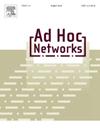Joint aerial base station placement and user association for aerial–terrestrial networks: A whale optimization approach
IF 4.4
3区 计算机科学
Q1 COMPUTER SCIENCE, INFORMATION SYSTEMS
引用次数: 0
Abstract
Aerial–terrestrial networks have been envisaged as a key feature of sixth generation (6G) communications to resolve the capacity and coverage issues of the existing terrestrial ground base stations (GBSs) via unmanned aerial vehicle-mounted base stations (ABSs). However, with the introduction of ABSs into the mobile networks, load balancing among ABSs becomes more challenging, as it additionally requires careful placement of ABSs in the three-dimensional (3D) airspace for coverage provisioning. Also, user quality of service (QoS) requirements and interference between ABSs and GBSs require meticulous management during the user association process for effective load balancing. In this paper, we propose a new joint ABS placement and user association scheme based on a whale optimization algorithm (WOA) for throughput maximization and load balancing in aerial–terrestrial networks. Firstly, a multi-objective ABS placement and user association problem is formulated for an aerial–terrestrial network to jointly maximize an -fairness-based load balancing utility function and the network throughput. Then, we develop a WOA algorithmic framework to solve the multi-objective problem, with each whale representing a candidate ABS placement solution, whose optimality is evaluated using a fitness function designed based on network throughput maximization and physical isolation constraints. Also, a QoS-aware greedy user association algorithm that maximizes the load balancing utility function is developed to facilitate the fitness evaluation of each whale. Simulation results show that the proposed scheme outperforms several state-of-the-art schemes in terms of Jain’s fairness index, probability of blocking and total throughput.
联合空中基地台安置与空中-地面网路的使用者关联:鲸鱼优化方法
空中-地面网络已被设想为第六代(6G)通信的一个关键特征,通过无人机安装的基站(abs)解决现有地面基站(GBSs)的容量和覆盖问题。然而,随着无线定位系统引入移动网络,无线定位系统之间的负载平衡变得更具挑战性,因为它还需要在三维(3D)空域中仔细放置无线定位系统以提供覆盖。此外,用户服务质量(QoS)需求以及abs和GBSs之间的干扰也需要在用户关联过程中进行细致的管理,以实现有效的负载均衡。在本文中,我们提出了一种新的基于鲸鱼优化算法(WOA)的联合ABS放置和用户关联方案,用于地空网络的吞吐量最大化和负载平衡。首先,提出了基于α-公平性的负载均衡效用函数和网络吞吐量最大化的多目标ABS布局和用户关联问题。然后,我们开发了一个WOA算法框架来解决多目标问题,每个鲸鱼代表一个候选ABS放置方案,使用基于网络吞吐量最大化和物理隔离约束设计的适应度函数来评估其最优性。同时,提出了一种具有qos感知的贪婪用户关联算法,该算法最大限度地利用负载均衡效用函数来实现每个鲸鱼的适应度评估。仿真结果表明,该方案在Jain公平性指数、阻塞概率和总吞吐量方面都优于当前几种方案。
本文章由计算机程序翻译,如有差异,请以英文原文为准。
求助全文
约1分钟内获得全文
求助全文
来源期刊

Ad Hoc Networks
工程技术-电信学
CiteScore
10.20
自引率
4.20%
发文量
131
审稿时长
4.8 months
期刊介绍:
The Ad Hoc Networks is an international and archival journal providing a publication vehicle for complete coverage of all topics of interest to those involved in ad hoc and sensor networking areas. The Ad Hoc Networks considers original, high quality and unpublished contributions addressing all aspects of ad hoc and sensor networks. Specific areas of interest include, but are not limited to:
Mobile and Wireless Ad Hoc Networks
Sensor Networks
Wireless Local and Personal Area Networks
Home Networks
Ad Hoc Networks of Autonomous Intelligent Systems
Novel Architectures for Ad Hoc and Sensor Networks
Self-organizing Network Architectures and Protocols
Transport Layer Protocols
Routing protocols (unicast, multicast, geocast, etc.)
Media Access Control Techniques
Error Control Schemes
Power-Aware, Low-Power and Energy-Efficient Designs
Synchronization and Scheduling Issues
Mobility Management
Mobility-Tolerant Communication Protocols
Location Tracking and Location-based Services
Resource and Information Management
Security and Fault-Tolerance Issues
Hardware and Software Platforms, Systems, and Testbeds
Experimental and Prototype Results
Quality-of-Service Issues
Cross-Layer Interactions
Scalability Issues
Performance Analysis and Simulation of Protocols.
 求助内容:
求助内容: 应助结果提醒方式:
应助结果提醒方式:


